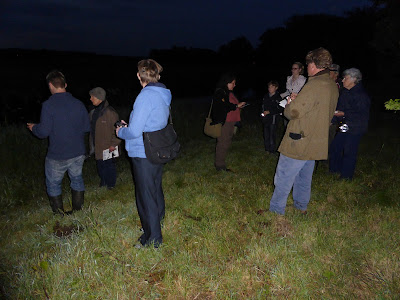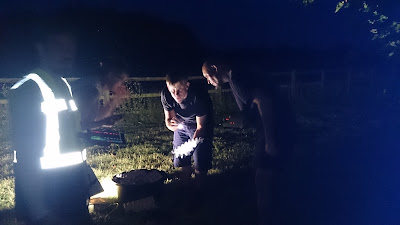Our next walk saw us visiting the lovely All Saints Church
in Swanton Morley on Saturday 20th of June 2015. Built in the 1300s,
All Saints is a grade I listed building, located close to the Wensum Way. It has
had a long history with bats, with a maternity colony of Natterer’s bats using
the building, and has been involved with recent research looking into ways to
implement techniques, that will provide a solution for churches affected by
large bat colonies, without causing undue harm to the resident bats.
At 21.00, we welcomed 7 people plus 2 volunteers, Laura and
Jamie. As the sun began to set, we headed down to the Wensum Way, a Norfolk
County Council Trail, aptly called the ‘River Walk’ by the locals. Taking us
into a beautiful Norfolk landscape consisting of open pastureland, hedgerows,
and fragmented woodland, it looked like promising territory for our walk.
Around 10 minutes into the walk, we heard our first bat, a
Noctule. Looking up we saw 2 Noctules flying above our heads (Noctule prefers
to fly in straight lines high up above the tree line, over open habitat),
followed shortly by a few others. Seeing these many Noctules, indicated to us
that their roost was probably nearby. Noctules tend to roost in trees,
particularly ones that have old woodpecker holes. We then heard our first
pipistrelle, a Soprano Pipistrelle, one of our smallest bats weighing between
4- 7g.
 |
| Learning how to use a bat detector © Norfolk Wild Nights, Sonia Reveley |
Progressing towards the River Wensum, we looked back towards
the church and we were rewarded with a view of the sunset lighting up the sky with
flashes of red, yellows, and gold. This view was in stark contrast with the sight
we saw when we arrived at the side of the river, a darkening horizon and mist
rolling into the fields. It was here that we heard and saw our first Daubenton’s
bat, a Myotis species that prefers water habitats and is aptly nicknamed ‘the
water bat’. Having satisfied ourselves with listening to Daubenton’s and
Soprano Pipistrelles by the riverside, we started our journey back to the
church and heard our first Natterer’s, most likely part of the colony exiting
from the church. In addition, we also heard some Common Pipistrelles as they
flew along the hedgerows.
On arriving back to the church faced with the possibility of
getting caught up in the impending rainstorm, we quickly checked the moth trap
that we set up earlier. We found a Straw Dot, Small Magpie, Heart and Dart and
2 Dark Arches. Afterwards when packing up the equipment we also found an
Elephant Hawkmoth and a Figure of Eighty moth.
 |
| Moth trapping © Norfolk Wild Nights, Sonia Reveley |
Thank you all for coming along. Your support for the project
has been much appreciated.




No comments:
Post a Comment